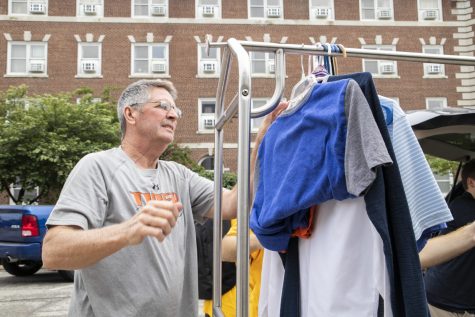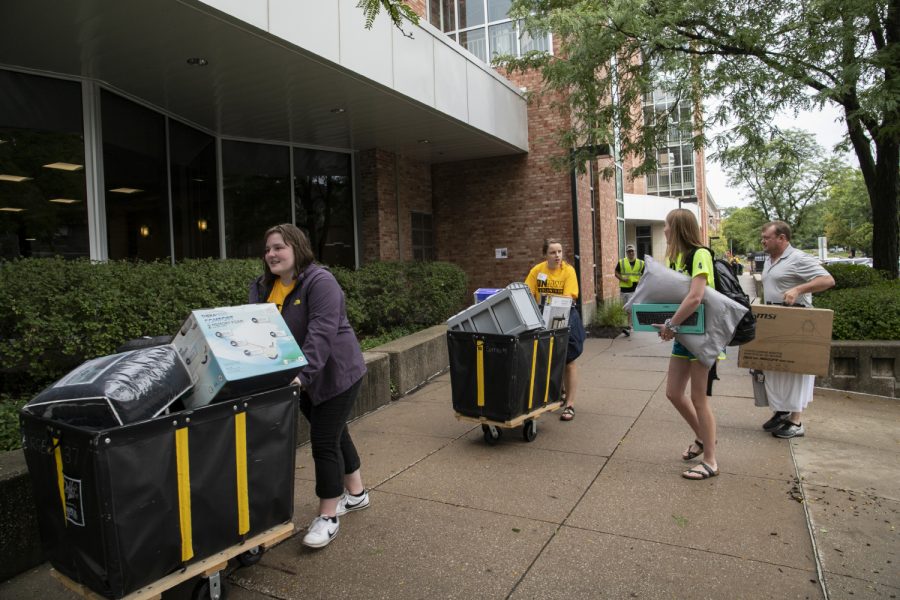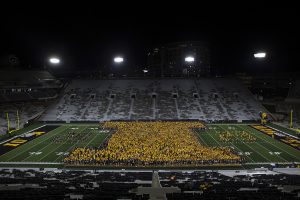Expanded housing returns as residence halls overflow
The UI is again housing students in residence-hall lounges with a spike in first-year student enrollment and more returning students living in the residence halls.
On-Iowa volunteers help a family move items into Burge Hall during move-in on Tuesday, August 20, 2019.
August 26, 2019
Earlier this month, University of Iowa President Bruce Harreld told the state Board of Regents, “We’re very creatively looking to make sure we have adequate space for all the students that we’re seeing coming in.”
The UI’s solution to housing the larger-than-anticipated first-year student population: Reviving expanded housing in the residence-hall lounges.
Expanded housing puts the overflow of students in residence-hall lounges temporarily until a permanent room opens up. The UI last used expanded housing for students living in residence halls in 2016.
The lounges used for expanded housing will be set up with bunk beds, dressers, and hanging racks for occupants to use, Senior Director of UI Housing & Dining Von Stange said. The students in these spaces will be charged $10 a day for living in that space instead of the typical rate for housing, he noted.
“We’ll move students from expanded housing to permanent spaces as soon as we’re able, after the first couple of weeks, when we know where everyone is,” Stange said. “But students will be in permanent spaces. Our hope is to have them in [a permanent space] by midterms.”

A family member hangs clothes on a cart outside Burge Hall during move-in on Tuesday, August 20, 2019.
For the 2019-20 academic year, the UI experienced an enrollment spike in the incoming first-year class after explaining enrollment declines by pointing to its enrollment-management strategy.
By the end of move-in week, around 6,400 students are expected to be living in the residence halls, Stange said. In the UI’s fiscal 2020 budget, however, the university had reported to the regents a fall residence-hall occupancy of 6,200 students.
In a February report to the regents on residence systems at the three public universities, the UI projected the residence-hall occupancy to hover around 91 percent annually through fiscal 2024, meaning there would be open beds across campus.
The UI then received approval from the regents in April to raise residence-hall rates by 2 percent for all but one standard room for the upcoming academic year. The university simultaneously expected the hall occupancy to decrease as the price rose.
“With Catlett opening and the university managing enrollment, we’ve been in a really good situation making sure we have enough space for every student who comes in,” Stange said, referring to residence-hall space in past years.
The UI has also spent the past few years marketing the residence halls to returning students as an alternative to moving off-campus in order for them to save money and receive academic support.
A pilot Living Learning Community in Catlett called the Second-Year Experience has sprouted, aimed at giving returning students opportunities to enhance their educational experience through building portfolios and interacting with faculty.
The LLC is almost full, and the UI will look at expanding the program to second-year students not living in the LLC if this year goes well, Stange said.






